
Regular Issue, Vol. 11 N. 1 (2022), 81-96
eISSN: 2255-2863
DOI: https://doi.org/10.14201/adcaij.27904
 |
ADCAIJ: Advances in Distributed Computing and Artificial Intelligence Journal
Regular Issue, Vol. 11 N. 1 (2022), 81-96 eISSN: 2255-2863 DOI: https://doi.org/10.14201/adcaij.27904 |
Charge/Discharge Scheduling of Electric Vehicles and Battery Energy Storage in Smart Building: a Mix Binary Linear Programming model
Zahra Foroozandeha, Sérgio Ramos, João Soares, Vale Zita, and António Gomes
Research Group on Intelligent Engineering and Computing for Advanced Innovation and Development (GECAD), Polytechnic Institute of Porto, School of Engineering (ISEP), 4200-072 Porto - Portugal
zah@isep.ipp.pt; scr@isep.ipp.pt; zav@isep.ipp.pt; jan@isep.ipp.pt; aag@isep.ipp.pt
ABSTRACT
Nowadays, the buildings have an important role on high demand of electricity energy. Therefore, the energy management of the buildings may have significant influence on reducing the electricity consumption. Moreover, Electric Vehicles (EVs) have been considering as a power storage devices in Smart Buildings (SBs) aiming to reduce the cost and consuming energy. Here, an energy management framework is proposed in which by considering the flexibility of the contracted power of each apartment, an optimal charging-discharging scheduled for EVs and Battery Energy Storage System (BESS) is defined over long time period to minimize the electricity cost of the building. The proposed model is design by a Mixed Binary Linear Programming formulation (MBLP) that the charging and discharging of EVs as well as BESS in each period is treated as binary decision variables. In order to validate the model, a case study involving three scenarios are considered. The obtained results indicate a 15% reduction in total electricity consumption cost and consumption energy by the grid over a one year. Finally, the impact of capacity and charge/discharge rate of BESS on the power cost is analyzed and the optimal size of the BESS for assumed SB in the case study is also reported.
KEYWORD
energy resource management; electric vehicles; battery energy storage system; mixed-binary linear programming; smart buildings
1. Introduction
Up to now, significant investment in Distributed Generation (DG) has been made worldwide. The main goal of the investment is to popularize Renewable Energy Sources (RES) in order to reduce energy consumption of grid mainly in residential buildings (Joench et al., 2019). In this regards, the Japanese government implemented 70,000 photovoltaic generations (PV) in 1994, an investment that was 50% subsidized. German government in 1999 launched the 100,000 Roofs Solar Program and in 2017, China had the largest power capacity of wind turbines in the world with 164 GW installed and the United States and Germany has reached 89 GW and 56.1 GW, respectively. The European Union (EU) intend that the new buildings could be more efficient in terms of electricity consumption and it encourage to increase the the number of the nearly Zero Energy Buildings (nZEB) (Zahra et al., 2020). To achieve this, the EU has strongly promoted development of RES and and adequate strategies for their operation (Joench et al., 2019). In the recent years, EVs have had remarkable development to reduce the energy consumption and electricity cost. New techniques are investigated that use the electrical energy stored in EVs to inject into the grid at appropriate times (Vehicle-to-Grid (V2G))(Sortomme and El-Sharkawi, 2011; Jian et al., 2015). The advantages of EVs have motivated many researchers to model the concepts of EVs. Many of these studies have considered the impact of EVs charging and discharging process as well BESS on power systems and electricity costs (Wang et al., 2011).
In (Haidar et al., 2018), a consumer-dependent system is proposed for the SBs to reduce the CO2 emission as well electricity cost. In this system, a Linear Programming (LP) is proposed in which the manager of an SB decides to use renewable energy even if it is more expensive than the non-renewable sources. In this model, the energy cost of SBs is minimized by considering some weights related to each type of the source (renewable and non-renewable) that the building manager prefers to use the initially provided, acceptability of consumer and the their price. Moreover, renewable and non-renewable sources and supply of energy by a diesel generator and restriction of minimum and maximum for BESS are limited, that are used as a constraint in the LP model. Reference (Molina et al., 2012) proposed a LP model that result in an optimal scheduling for charging and discharging processes for EVs in SBs. In this work, the demand power of SBs and the produced energy by PV is predicted using Artificial Neural Networks (ANN). In addition, some limitations for the State of Charge (SOC) of EVs and the rate of charging and discharging are considered in minimizing the total energy cost. Besides, the EVs must charge fully at the end of the period and the system can not inject into the grid. The model developed by (Thomas et al., 2016a) and (Thomas et al., 2017) considers use of local projections in SBs and EVs as an energy resource. The model in (Thomas et al., 2016a) minimizes the buildings power demand and its electricity costs by optimizing the charging and discharging process of Plug-In Hybrid Electric Vehicles (PHEVs).The restrictions contain limitations for the SOC of the PHEV and imposes that the energy grid is not sold and bought at the same time. The work by (Thomas et al., 2016b) proposed a MILP model to analyze the impact of a PHEV fleet on SBs in Belgium in which the energy demand and electricity costs were minimized as in(Thomas et al., 2016a) such that SOC of PHEVs should be between a given range and the balance of energy system must be satisfied as well. Here, the charging and discharging process of PHEV does not happen at the same time that is modeled using binary variables. The proposed MILP model in (Sabillón A. et al., 2015) optimizes the charging and discharging process in EVs as well as an energy storage system to find an appropriate daily schedule time. In this model, the arrival and departure time periods of the EVs and and initial SOC of EVs and an energy storage system are considered to be known.
In (van der Meer et al., 2018), an MILP model is consider in which the PV generation is included via a forecasting model, and the objective function is to minimize EVs charging cost and increase the energy consumption from the PV generation. In (Erdinc et al., 2015), a Home Energy Management (HEM) system is considered that contains a small-scale renewable energy generation and BESS. The model is based on an MILP formulation in witch V2G and demand response strategies are considered. In paper (Zahra et al., 2020; Foroozandeh et al., 2022), an energy management system was aiming to minimize the peak load power demand in an SB where the contract for each apartment is assumed to flexible. In this work, the schedule of the EVs/BESS charge and discharge is optimized using a MBLP model in which the charging/discharging of EVs and BESS in each time period is modeled by binary variables.
In this paper, a mathematical optimization problem is proposed seeking to reduce the total cost of consuming energy. We consider energy resources such as EVs, BESS and PC, and assume flexible contracts for all customers and that there is a single contract for the whole building. Moreover, the data of the SB load consumption, arrival and departure time of EVs and PV are considered according to a forecast strategy. The presented model is an MBLP problem on management of energy resources in a SB that results in an optimal schedule for charging/discharging of EVs and BESS with a lower total cost. Here, the considered time period is long and the EVs can perform the V2G process. And finally, impact of the size of BESS on the total price is analyzed. This paper contains five following sections: In Section 2, a brief of methodology, problem description and some assumptions that are used in this work are presented. Section 3 presents the MBLP model. Then, the details of case study such as definition of three different scenarios and the parameters value are reported in Section 4. In section 5, the proposed method is implemented for scenarios and then a comparison and discussion of the obtained results are provided. Finally, a conclusion is presented in the last section 6.
2. Problem Description
We consider a Smart Buildings (SBs) which manages its local grid containing apartments, PhotoVoltaic (PV) generation panels, Electric Vehicles (EVs) and a Battery Energy Storage System (BESS). In the considered SB, the power generated by PVs is used for apartment consumption and charging batteries of EVs and BESS. Moreover, PVs can inject their power to the external grid. In addition, EVs have bidirectional embedded chargers, such that their batteries can be charged from grid, PVs and BESS; and discharged to apartments and grid. In the considered SB, BESS is used to balance the demand and supply power. It can be discharged to apartments, EVs and grid, and charged from grid and PVs. In addition, the following assumptions are made during this article.
•Each EVs has only one trip in each day. EVs are plugged in as soon as arrive home. Moreover, the time of arrival and departure are known.
•For each EV, the initial SOC is known at arrival time in each day. The EV battery could be charged/discharged between arrival and departure time. However, the SOC of each EV, in the departure time, must be greater than a predefined value.
•There are known physical limitations in the charging rate and capacity of EVs’ batteries and BESS.
We study SB in a given long time-period, which contains many days. It is presented a charging/discharging EVs schedule and BESS such that minimize the total cost of grid energy in the time-period. Of course, the mentioned constraints must be maintained.
3. Mathematical Model
In this Section, a MBLP is proposed to mathematically model the stated problem in Section 2. Let the considered time-period contains D day(s) and then we divide each day to some step-times with duration τ. Let the I be the number of all time-steps in the time-period. Moreover, let J denotes the number of EVs. Before developing the model, we declare the needed sets, parameters and decision variables. The sets of the model is defined in Table 1.
Table 1. List of Sets considered in the Model
Symbol |
Set |
Running Index |
Description |
𝕀 |
{1, …, I} |
i |
Set of time-step numbers |
J |
{1, …, J} |
j |
Set of Vehicle numbers |
D |
{1, …, D} |
d |
Set of day numbers |
Based on the discussions of Section 2, the required parameters are listed in Table 2, in which the description of parameters is presented as well.
Table 2. Parameters of the model (17)
Parameter |
Index |
Description |
D |
|
Number of Days per Time-Study |
I |
|
Number of time-steps per Time-Study |
τ |
|
time-step duration (hour) |
J |
|
Number of apartments (or EVs) in the building |
j ϵ J, d ϵ {0} υ D |
For d = 0, and for d ϵ D, is the number of period-time in which jth EV enters to the parking in day d |
|
j ϵ J, dϵDυ{D+1} |
For d ϵ D, is the number of period-time in which the jth EV leaves in day d and for d = D + 1, |
|
j ϵ J |
Maximum allowable State of Charge(SOC) of jth EV |
|
j ϵ J, d ϵ {0} υ D |
The initial SOC of jth EV at the beginning departure in time period |
|
j ϵ J, d ϵ D |
The minimum allowable SOC for jth EV at exit time of each day d |
|
|
Maximum State of Charge(SOC) for BESS |
|
|
Initial State of Charge(SOC) for BESS at the beginning of time-period |
|
|
Minimum State of Charge(SOC) for BESS |
|
PSB(i) |
i ϵ 𝕀 |
Total power demand of Smart Building (SB) at period i |
PPV(i) |
i ϵ 𝕀 |
Total generated power by PhotoVoltaics (PVs) at period i |
i ϵ 𝕀 |
Maximum power that can got form Grid at time-step i |
|
|
Purchased electricity cost from grid in i-th time-step |
|
|
|
|
j ϵ J |
Active power related to the charging process of the jth EV (kW) |
|
j ϵ J |
Active power related to the discharging process of the jth EV |
|
j ϵ J |
The charge efficiency of EV j |
|
j ϵ J |
The discharge efficiency of EV j |
|
i 2 𝕀 |
Active power related to the charging process of the BESS in periodi (kW) |
|
i ϵ 𝕀 |
Active power related to the discharging process of BESS in period i (kW) |
However, we should note that d ϵ D stands for index of days, whereas d = 0 and d = D + 1 are appeared as the index of some parameters in 2. Indeed, these indices are stand for the beginning and end times of the considered time-period. In this way, for refers to arrival time-step in d-th day, but and refer to the first and last time-steps. To make a better sense on the role of parameters, see Figure 1.
Figure 1. Visualizing the exit and arrival times for j-th EV and the relevance parameters

Moreover, the considered decision variables are presented in Table 3. The binary variables and are used to define the charging and discharging state of j-th EV in i-th time-step. means that the battery of j-th EV is charging (discharging) in time-step i. The binary variables and are similarly used for charging/discharging state of BESS.
Table 3. Decision variables of the model (17)
Variable |
Type |
Index |
Description |
αEV(i, j) |
{0,1} |
i ϵ I, j ϵ J |
Binary variable that represents EV j charging process in period i |
βEV(i, j) |
{0,1} |
i ϵ I, j ϵ J |
Binary variable that represents EV j discharging process in period i |
αEV(i) |
{0,1} |
i ϵ I |
Binary variable that represents the BESS charging process in period i |
βEV(i) |
{0,1} |
i ϵ I |
Binary variable that represents the BESS discharging process in period i |
SEV(i, j) |
i ϵ I, j ϵ J |
SOC of the EV j at the start of period |
|
SBE(i) |
i ϵ I |
SOC of the BESS at the start of period i |
|
PG(i) |
i ϵ I |
Active power extracted from the grid in period i(kW) |
|
i ϵ I |
Active power related to charging the BESS by grid in period i |
||
i ϵ I, j ϵ J |
Active power related to charging the EV j by grid in period i |
||
i ϵ I, j ϵ J |
Active power related to discharging of EV j to SB in period i. |
||
i ϵ I |
Active power related to cover the consumption SB by PV in period i |
||
i ϵ I |
Active power related to charging the BESS by PV in period i |
||
i ϵ I |
Active power related to inject of PV to grid in period i |
||
i ϵ I |
Active power related to inject of BESS to grid in period i |
It is noted that, if j-th EV is out of SB in time-step i, then the variable is meaningless and should not be considered in the model. On the other hand, as we see in Table 1, the index i of is considered in I. Indeed, for simplicity in presentation, we consider index i ϵ I for SEV and we will care about in this issue in the objective function and constraints.
3.1. Objective Function
In this paper, it is intended to minimize the total cost of power grid. In this regard, the following objective function is considered
Here, the first term of the (1) corresponds to the energy cost that is delivered by the grid to building, BESS and EVs. And the second term represents the cost of the energy that is injected to grid by PVs, BESS and EVs.
3.2. Constraints
In what follows, we present the constraints should be considered in MBLP model. These constraints are necessary to ensure that the physical limits of resourse and problem assumptions do not violated.
3.2.1 EVs Constraints
The capacity of j-th EV’s battery is . Thus, the following capacity constraints must be considered
We recall that, the arrival time and initial charge of j-th EV in each day d is known and are referred by and , respectively. Accordingly, we consider the following constraints
For i ϵ I and j ϵ J, if αEV (i, j) = 0, then no power from grid is consumed for charging EV j, i.e., Otherwise, if αEV(i, j) = 1, then EV j could be charged from grid in time-step i. In this case, during time-step i, EV can consume at most power from the grid to charge its battery. At all, the consumed power from grid to charge EVs satisfies the following constraint
Also, batteries of EVs can be discharged to feed demand power of the building or injected to the grid. In similar manner, the following constraints are considered for the power obtained by discharging EVs
In each time-step, SOC of EVs may be changed due to charge or discharging. Note that, and show the charging and discharging state of j-th EV in i-th time-step. Consequently, at the end of time-step i, the SOC of j-th EV is updated as
The minimum allowable SOC for j-th EV at departure time is . In this respect, the following constraints are considered at the departure time-steps.
In day d ϵ D, in time-steps , EV j is not in the parking.
In these time-steps the charging and discharging should not occur. Accordingly, we consider the following constraints in the mentioned time-steps
The following constraints are take in to the account, to grantee that the charging and discharging of EVs do not occur at the same time
3.2.2 BESS Constraints
Due to the capacity limitation of BESS, in each period i ϵ I, the following constraints are considered on the SOC of BESS
In each time-step i, if αBE (i) = 1, then BESS can be charged by grid or PVs. Moreover, if βBE (i) = 1, then BESS can feed grid and apartments of the building. This charge/discharging can be modeled by the following constraints
Off course, the BESS cannot charge and discharge at the same period i. To force this point, the following constraints are considered
3.2.3 Load Grid Constraints
In each period i ϵ I, the power of grid is used to feed the building, EVs and BESS. Accordingly, the following constrains should be considered
Moreover, we have bound on the consuming grid power. Accordingly, we consider the following bound constraints
3.3. Summary
Based on the above discussions, the mathematical model of the problem is as
The decision variables are those that sketch in Table 3. This optimization problem is a MBLP.
4. Case Study
As a case study, we consider a real residential building with 15 apartments, 15 cars and 3 PVs. Our aim is to study this building at 2019. In this building, for each 15 minutes, energy consumption of apartments, generated power by PVs and arrival/departure of cars are recorded. These recorded data are considered as input data, which evaluate the parameters PSB, PPV, and . However, due some technical issue, some records are missed in the collected data. In this regard, we used regression and adjacent interpolation to estimate and forecast the missed records.
As mentioned, the data are collected for each 15 minute of year. Accordingly, the time-period is equal to one year(365 days) and τ = 0.15 minuts. In this way, each day is divided to 24 × 4 = 96 time-steps and consequently, the time-period contains I = 96 * 365 = 35040 time-steps.
Now, we suppose that each car in the building is replaced by a EV with the following configurations (come from the BMW i3 94 Ah).
Moreover, we assume that the building is equipped by an BESS with the following features
We mentioned that, in order to validate the developed model close to real situations, the above characteristics of the EVs and the BESS are considered based on the market specifications. In addition, the initial SOC of BESS at the beginning of time-period and initial SOS of EVs at each arrival time of day are set randomly.
Our aims in this paper is to investigate advantageous of the considering battery of EVs and an extra BESS as power storage devices. In this regard, the following scenarios are considered.
•In the base scenario, the discharge process of the EVs does not consider. Moreover, BESS is not considered, too. In this scenario, just the charging time of EVs is scheduled and for this purpose, the presented MBLP (17), with βEV (i, j) = 0 and αBE(i) = βBE (i) = 0 is considered.
•In the second scenario, the charging and discharging process of EVs are considered but similar to base scenario, the BESS is not used. In this scenario, MBLP (17), with αBE (i) = βBE(i) = 0 is considered to provide charge/discharge schedule of EVs.
•The proposed problem in Section 2 is considered as the third scenario. In this scenario, we intend to optimize the charging/discharging schedule of EVs and BESS by solving MBLP (17).
5. Simulation Results
In this section, the mentioned three scenarios of the case study is studied by solving the proposed MBLP model (17). Our aim is to highlight the advantageous of scenario 3 over the other senarios in term of power price.
To solve MBLP (17), it is modeled in AMPL (A Mathematical Programming Language) (Fourer et al., 1989) and the CPLEX solver (?) is used.
5.1. Experiment 1: Visualizing the results of the three scenarios
As the first experiment, we solve the model (17) for three scenarios and report the obtained total costs (Objective functions) in Table 4. Moreover, the monthly values of the energy cost in scenario 1, 2 and 3 are compared in Figure 2.
Table 4. Total Cost and Energy For All Scenario during 1 year
|
Objective Function |
PG |
Scenario 1 |
17458.0895 |
100270.995 |
Scenario 2 |
15682.2486 |
90034.118 |
Scenario 3 |
14814.65992 |
84002.393 |
Figure 2. Total Cost and Energy For All Scenario during 1 year
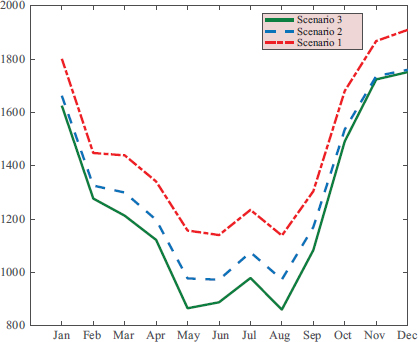
As we see, in the middle months (May-Aug), thank to more efficiency of PVs, the total cost is reduced in the three scenarios. Moreover, allowing EVs to discharge and using BESS lead to reducing the power cost, such that the cost of power in Scenario 3 is less than Scenario 2 and also Scenario 2 is less than Scenario 1. More precisely, it can be seen that the Scenario 2 leads to 11% reduction, whereas Scenario 3 was able to reduction of 15%. In what follows, we illustrate that why these reductions are happened.
In Figure 3, the consumed power from grid, generated power by PVs, the building demand and power consumed for charging EVs are plotted for days 180 to 183 of the year. Moreover, the interactions between producers and consumers are specified by different colors. In similar fashion, Figure 4 shows the results of scenario 2.
Figure 3. [Scenario 1, days 180 to 183]: Trace of power between Grid, Building’s apartments, Pvs and EVs
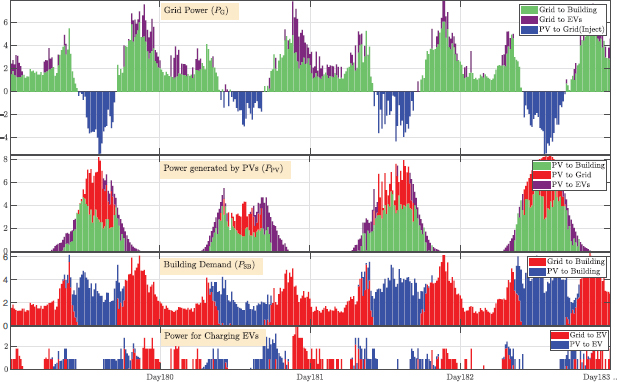
Figure 4. [Scenario 2, days 180 to 183]: Trace of power between Grid, Building’s apartments, Pvs and EVs
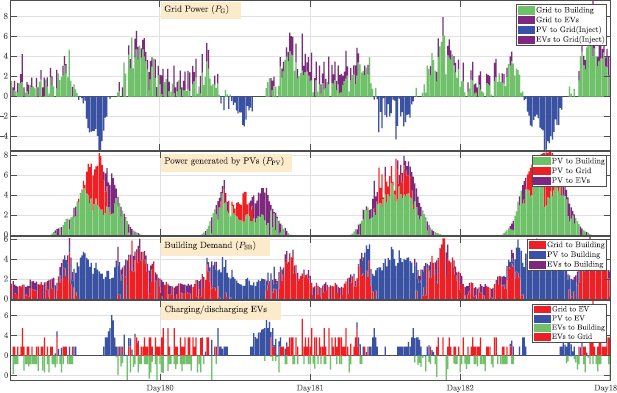
As we see, in scenario 2, in some step-times, some power generated by PVs are used for charging EVs’ battery and at other time-steps, the batteries of EVs are discharged to reduce the consumed power from grid. Indeed, in scenario 2, EVs are used as a storage for PVs, such that the consuming/injecting power from/to grid is reduced. Consequently, since the cost of selling power in comparison with buying power is insignificant, in scenario 2, the power cost is reduced.
However, in both scenarios at the middle of days, significant amount of the power generated by PVs is injected to grid. At these times, the EVs are outside of building and their batteries could not be used as storage for EVs. As we mentioned before, the idea of the scenario 3 is to store the extra power and use it in other times. To show the impact of considering BESS, in Figure 5, the interaction between SB components are illustrated. As this figure shows, just little power is injected to the grid and BESS stores the generated power by PVs and discharges in peak loads time-steps.
Figure 5. [Scenario 3, days 180 to 183]: Trace of power between Grid, Building’s apartments, Pvs, EVs and BESS
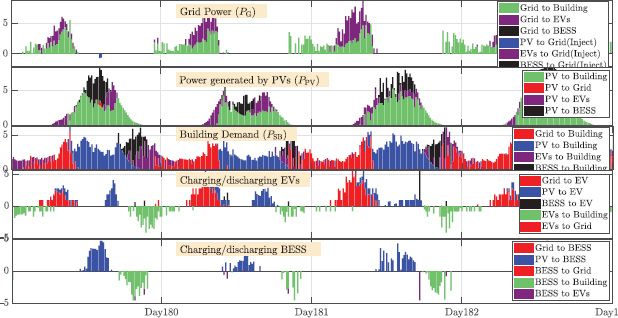
5.2. Experiment 2: Optimal Battery sizing and charge/discharge rate
In this paper, BESS is used to improve the power consumption in the building. Here, we provide some results that help the managers of the building to select optimal characteristics of the BESS. More precisely, we report the impact of capacity and charge/discharge rate of BESS on the power price of the building. In Figure 6, the power cost of SB for various values of capacity and charge/discharge rate is plotted. Based on this figure, we see that in this case study, there in no need to a battery with high capacity. Moreover, the rate of charge and discharge are effective factor. As we see, for the building in considered case study, if the charging and discharging times of BESS are 1 and 0.9 hour, respectively, the capacity 40 is optimal. Moreover, if charging/discharging time is 6/5.4 hour, then capacity 70 is optimal.
Figure 6. The power price of SB for based on various values of BESS capacity and charge/discharge rate
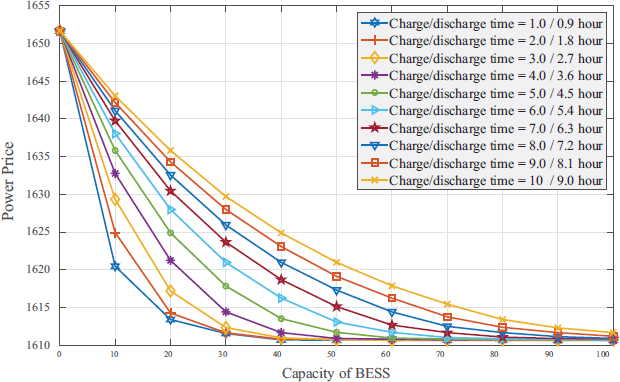
6. Conclusion
This work proposes an MBLP model that minimizes the total cost of energy for the SB. The model considers the PV generation panel, EVs and a BESS. The main contribution of this work is the flexibility of the contract power for each apartment and considering single contract power for whole building. Therefore, each apartment can consume electricity energy as long as it does not exceed the installed contract power of building. Otherwise, the demand response programs are used to impose a fine. The results of our three scenarios show the efficiency of the model. In the first scenario that only the charging process of EVs are considered, the total cost was incurred. The proposed MBLP formulation is aiming to decrease the total cost by adding discharging process of EVs in scenario 2 and also considering the charging and discharging process of BESS and EVs in scenario 3. The applied strategy in scenario 2 leads to reducing the total cost and consumption from the grid by 11% in comparison with scenario 1. Then, the impact of the optimization of the charging and discharging schedule of EVs and BESS in energy management in the SB is analyzed in scenario 3. It is implied that this process reduces cost of energy consumption from the grid by 15%compared to scenario 1. Finally, The impact of the capacity and charging/discharging rate of the BESS on the total cost is studied.
7. Acknowledgements
This work has received funding from FEDER Funds through COMPETE program and from National Funds through FCT under the project BENEFICE–PTDC/EEI-EEE/29070/2017 and UIDB/00760/2020 under CEECIND/02814/2017 grant.
References
Erdinc, O., Paterakis, N. G., Mendes, T. D. P., Bakirtzis, A. G., and P. S. Catalão, J., 2015. Smart Household Operation Considering Bi-Directional EV and ESS Utilization by Real-Time Pricing-Based DR. IEEE Transactions on Smart Grid, 6(3):1281–1291.
Foroozandeh, Z., Ramos, S., Soares, J., Vale, Z., and Dias, M., 2022. Single contract power optimization: A novel business model for smart buildings using intelligent energy management. International Journal of Electrical Power Energy Systems, 135:107534. ISSN 0142-0615. https://doi.org/10.1016/j.ijepes.2021.107534.
Fourer, R., Gay, D. M., and Kernighan, B. W., 1989. AMPL: A Mathematical Programing Language. In Wallace, S. W., editor, Algorithms and Model Formulations in Mathematical Programming, pages 150–151. Springer Berlin Heidelberg, Berlin, Heidelberg. ISBN 978-3-642-83724-1.
Haidar, N., Attia, M., Senouci, S.-M., Aglzim, E.-H., Kribeche, A., and Asus, Z. B., 2018. New consumer- dependent energy management system to reduce cost and carbon impact in smart buildings. Sustainable Cities and Society, 39:740–750. ISSN 2210-6707. https://doi.org/10.1016/j.scs.2017.11.033.
Jian, L., Zheng, Y., Xiao, X., and Chan, C. C., 2015. Optimal scheduling for vehicle-to-grid operation with stochastic connection of plug-in electric vehicles to smart grid. Applied Energy, 146:150–161. ISSN 0306-2619. https://doi.org/10.1016/j.apenergy.2015.02.030.
Joench, R. L., Soares, J., Lezama, F., Ramos, S., Gomes, A., and Vale, Z., 2019. A Short Review on Smart Building Energy Resource Optimization. In 2019 IEEE PES GTD Grand International Conference and Exposition Asia (GTD Asia), pages 440–445.
Van der Meer, D., Mouli, G. R. C., Elizondo, L. R., and Bauer, p., 2018. Energy Management System With PV Power Forecast to Optimally Charge EVs at the Workplace. IEEE Transactions on Industrial Informatics, 14:311–320.
Molina, D., Hubbard, C., Lu, C., Turner, R., and Harley, R., 2012. Optimal EV charge-discharge schedule in smart residential buildings. In IEEE Power and Energy Society Conference and Exposition in Africa: Intelligent Grid Integration of Renewable Energy Resources (PowerAfrica), pages 1–8.
Sabillón A., C. F., Franco, J. F., Rider, M. J., and Romero, R., 2015. A MILP model for optimal charging coordination of storage devices and electric vehicles considering V2G technology. In 2015 IEEE 15th International Conference on Environment and Electrical Engineering (EEEIC), pages 60–65.
Sortomme, E. and El-Sharkawi, M. A., 2011. Optimal Charging Strategies for Unidirectional Vehicle-to-Grid. IEEE Transactions on Smart Grid, 2(1):131–138.
Thomas, D., Deblecker, O., Bagheri, A., and Ioakimidis, C. S., 2016a. A scheduling optimization model for minimizing the energy demand of a building using electric vehicles and a micro-turbine. In 2016 IEEE International Smart Cities Conference (ISC2), pages 1–6.
Thomas, D., Deblecker, O., Genikomsakis, K., and Ioakimidis, C. S., 2017. Smart house operation under PV and load demand uncertainty considering EV and storage utilization. In IECON 2017 - 43rd Annual Conference of the IEEE Industrial Electronics Society, pages 3644–3649.
Thomas, D., Ioakimidis, C. S., Klonari, V., Vallée, F., and Deblecker, O., 2016b. Effect of electric vehicles’ optimal charging-discharging schedule on a building’s electricity cost demand considering low voltage network constraints. In 2016 IEEE PES Innovative Smart Grid Technologies Conference Europe (ISGT- Europe), pages 1–6.
Wang, J., Liu, C., Ton, D., Zhou, Y., Kim, J., and Vyas, A., 2011. Impact of plug-in hybrid electric vehicles on power systems with demand response and wind power. Energy Policy, 39(7):4016–4021. ISSN 0301-4215. https://doi.org/10.1016/j.enpol.2011.01.042.
Zahra, F., Sérgio, R., Soares, J., Fernando, L., Zita, V., Antonio, G., and Rodrigo, L. J., 2020. A Mixed Binary Linear Programming Model for Optimal Energy Management of Smart Buildings. Energies, 13(7):1719. https://doi.org/10.3390/en13071719.
Author’s Biography

ZAHRA FOROOZANDEH received the Ph.D. degree in Applied Mathematics from Amirkabir University of Technology, Iran. She is a Scientific Researcher at the GECAD, Polytechnic of Porto, Portugal and an integrated member of the Research Center for Systems and Technologies (SYSTEC) in Portugal. Her research interests lie in Optimal Control, Calculus of Variations, Optimization, Numerical Analysis and their application to engineering problems such as power and energy systems.

SÉRGIO RAMOS received the Ph.D. degree in electrical and computer engineering from the Instituto Superior Técnico – University of Lisbon, Lisbon, Portugal, in 2015. He is currently Adjunct Professor with the Polytechnic Institute of Porto, Porto. His research interests include Data mining, artificial intelligence, power systems, electricity markets, renewable energy resources management, shared PV generation, and electricity communities.

JOÃO SOARES (Member, IEEE) received the B.Sc. degree in computer science and the master’s degree in electrical engineering from the Polytechnic Institute of Porto, in 2008 and 2011, respectively, and the Ph.D. degree in electrical and computer engineering from UTAD University, in 2017. He is currently a Researcher with ISEP/GECAD. His research interests include optimization in power and energy systems, including heuristic, hybrid, and classical optimization. He is the vice-chair of the IEEE CIS TF 3 on CI in the Energy Domain, and has been involved in the organization of special sessions, workshops, and competitions to promote the use of CI to solve complex problems in the energy domain.

ZITA VALE (Senior Member, IEEE) received the Ph.D. degree in electrical and computer engineering from the University of Porto, Porto, Portugal, in 1993. She is currently a Professor with the Polytechnic Institute of Porto, Porto. Her research interests include artificial intelligence applications, smart grids, electricity markets, demand response, electric vehicles, and renewable energy sources.

ANTÓNIO AUGUSTO ARAÚJO GOMES graduated and got M.SC in Electrical and Computer Engineering - Power Systems, both from the University of Porto. He is Professor at the Department of Electrical and Computer Engineering at Instituto Superior de Engenharia do Porto (ISEP), Polytechnic of Porto, since 1999.